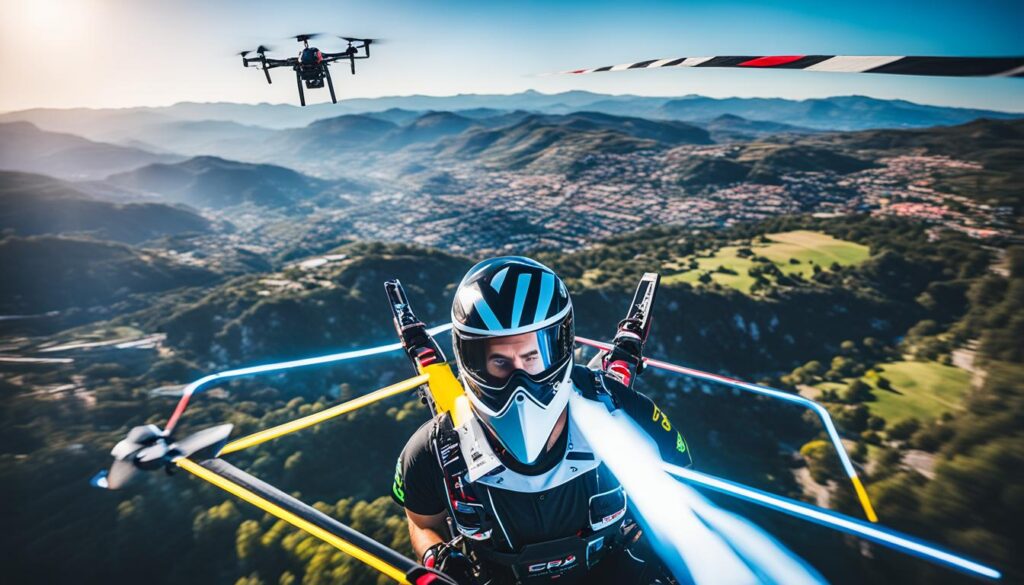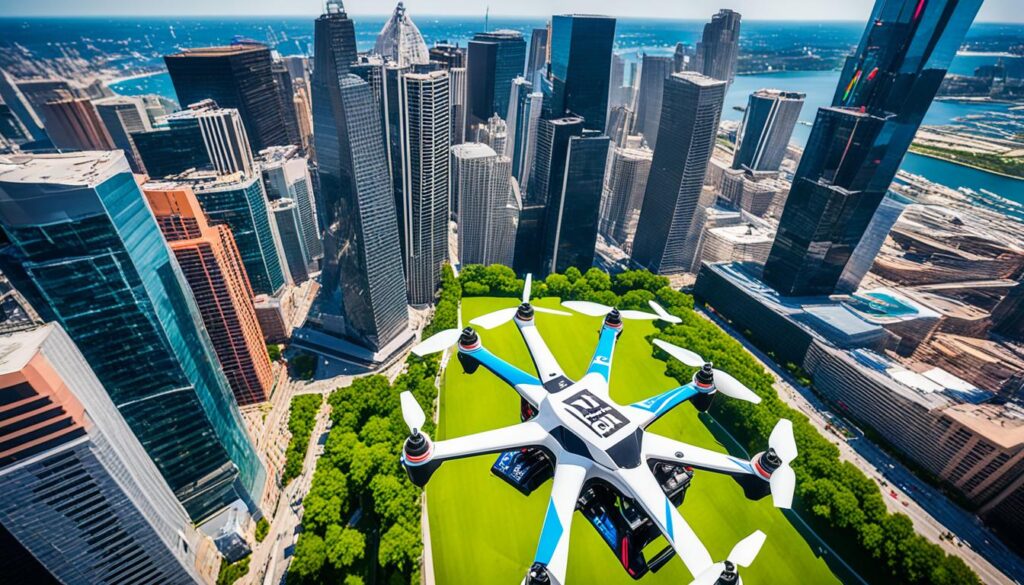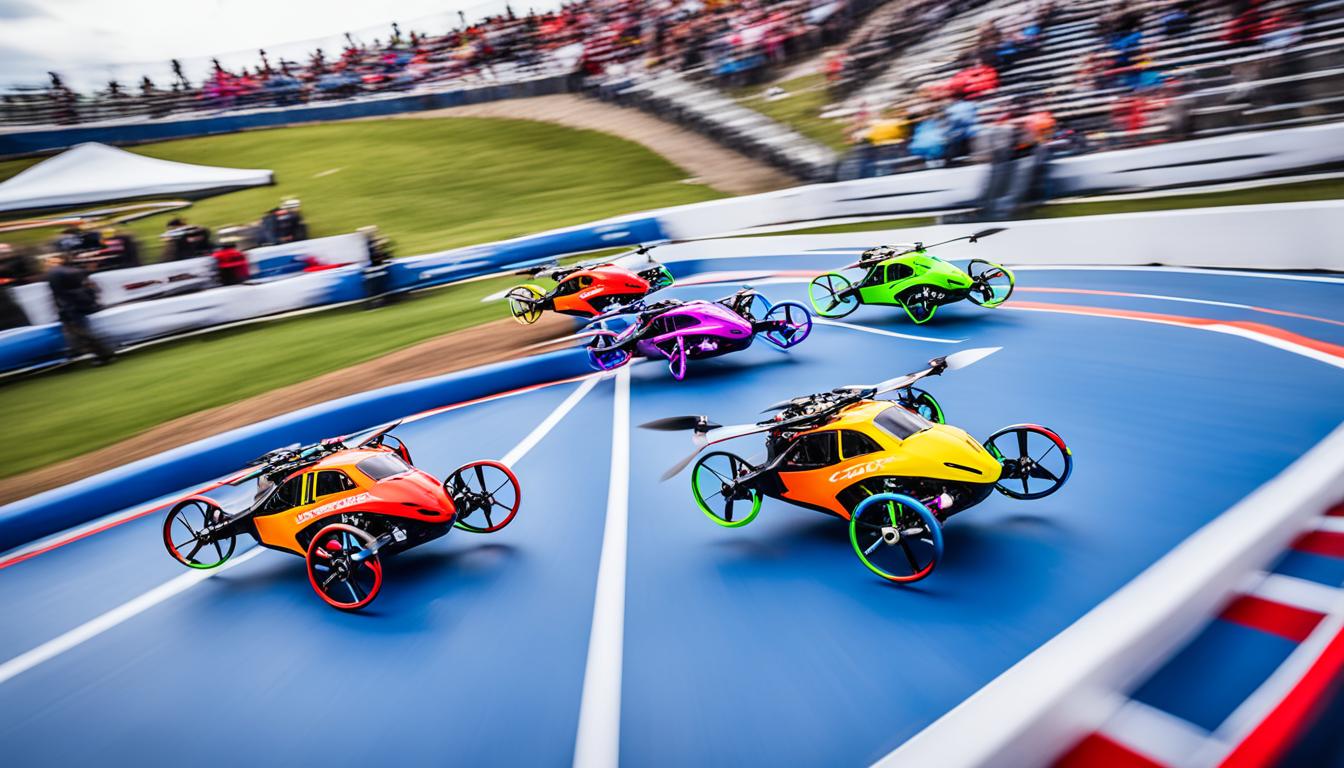Over $50 million has been given to research in high-speed robot navigation and drone racing. This shows how fast and exciting the sport of FPV (First-Person View) drone racing is getting. If you’ve ever wanted to fly fast, do cool moves, and feel the rush of racing, this guide is for you. It’s your first step into this thrilling, fast-paced sport.
Key Takeaways
- Drone racing is an immersive sport that combines the thrill of high-speed flight with the challenge of navigating complex aerial obstacle courses.
- FPV racing allows you to experience the action through the eyes of the drone, providing an unparalleled sense of speed and control.
- Mastering drone piloting skills, such as agile maneuvers and precise control, is essential for success in this sport.
- Drone racing has seen a rapid growth, with professional leagues and significant cash prizes attracting a global audience.
- Proper safety gear and an understanding of local regulations are crucial for enjoying drone racing responsibly.
What Is FPV Drone Racing?
FPV (First-Person View) drone racing has become a hit, drawing in thrill-seekers and tech fans. It’s a sport where pilots race quadcopter drones through aerial obstacle courses fast. They wear FPV goggles for a first-person view from the drone’s point of view.
The Thrilling World of First-Person View Racing
FPV drone racing gives pilots an immersive drone experience. They fly through complex courses and perform fast moves. It takes skill to navigate through tight spots and loops with these remote control aircraft.
Elements of Piloting Skill, Strategy, and Speed
FPV drone racing combines skill, strategy, and speed. Pilots need to know their drones well and think fast. They aim to beat the course and win, making it an adrenaline-fueled sport.
For both new and experienced racers, FPV drone racing is exciting. The thrill of racing at high-speed drone maneuvers makes it a fun hobby.
Essential Gear for Drone Racing
To dive into the excitement of FPV (First-Person View) drone racing, you need the right gear. At the core, racing drones are built for speed, agility, and toughness. Many pilots enjoy building their own custom rigs, picking parts to make a drone that’s all their own.
Racing Drones: Built for Agility and Speed
The racing drone is key, with many options for every skill level and budget. Beginners might start with drones like the DJI Mini 4 Pro or DJI Mini 3. Experienced racers might choose the LightSwitch Ultra or the Kronos for their speed and agility.
FPV Goggles: Your Window to the Action
For a real racing feel, you need FPV goggles. These goggles show you what your drone sees in real time. Top models like the DJI FPV Goggles V2 or the Fatshark Dominator HD V3 give clear video, low delay, and racing-specific features.
Remote Controllers, Batteries, and Tools
You’ll also need a quality remote controller to fly your drone well. Plus, LiPo batteries and a charger are key for power. Don’t forget a toolbox with spare parts and tools for fixing and adjusting your drone on the go.
“The thrill of FPV drone racing lies in the delicate balance of skill, strategy, and sheer speed. Mastering the right gear is the first step towards unlocking the full potential of this exhilarating sport.”
Learning the Basics of Drone Flight
Learning how to fly a drone is key to becoming a pro at drone racing. It doesn’t matter if you’re starting from scratch or have some flying skills. It’s important to begin with the basics and understand how to pilot your drone well.
Start by practicing simple moves, like:
- Hovering your drone in place
- Flying in figure-eight patterns
- Navigating through imaginary gates or obstacles
These exercises will help you understand how your drone moves and responds. You’ll learn to control the throttle and controls smoothly. Take your time and focus on flying steadily before trying harder moves.
As you get better, try more complex moves, like sharp turns, quick speeds, and sudden stops. The more you practice drone flight, the better your piloting skills will get. This will help you control your drone and get ready for drone racing.
“The key to becoming a skilled drone pilot is practice, practice, practice. Start slow, master the basics, and gradually build up your confidence and abilities.”
Remember, the more you practice flight practice, the better you’ll be at drone racing. Keep exploring, push your limits, and enjoy learning to fly like a pro.
Mastering Advanced Maneuvers
As you grow in the exciting world of FPV racing, it’s time to improve your flying skills. Using a drone racing simulator is a great way to do this. These simulators let you practice tricky moves like sharp turns and fast climbs safely. You can try out new skills and get quicker without worrying about breaking your drone.
Simulator Training for Risk-Free Practice
Drone racing simulators are great for pilots who want to get better. They let you experience the thrill of FPV racing safely. You can try out advanced drone maneuvers and piloting techniques without fear of damage or high repair costs.
Joining a Racing Community for Mentorship
Connecting with your local racing community is also key to improving your flying skills. Experienced pilots are often happy to share their knowledge with you. By joining a club or going to events, you can learn from pros, get coaching, and learn the latest racing techniques and simulator training. Being part of a supportive group will help you improve faster and reach new heights in FPV flying.
| Simulator Features | Community Benefits |
|---|---|
|
|

“Simulator training is the key to unlocking your full potential as a drone racer. It allows you to push the boundaries of your skills in a safe environment, preparing you for the adrenaline-fueled challenges of real-world racing.”
Drone Racing 101: Getting Started in the Fast-Paced Sport
The world of FPV drone racing is thrilling for those who love drones and seek excitement. It’s perfect for both new and experienced pilots. To start with quadcopter drones and FPV racing, here are the main steps:
- Invest in the right equipment: You’ll need high-performance racing drones, FPV goggles, and a reliable remote controller for a great experience.
- Master the basics of drone flight: Practice and simulation training will help you get better at takeoff, landing, maneuvering, and hovering.
- Join a local racing community: Meet experienced pilots, learn from them, and join in on friendly races to improve your skills.
- Familiarize yourself with safety protocols and regulations: It’s crucial to fly responsibly and know the local rules for a safe and fun time.
- Embrace the thrill of competition: Once you’re ready, enter local or national drone races to test your skills and challenge yourself.
Starting in FPV drone racing requires patience, practice, and a love for excitement. Be ready to face challenges, learn from mistakes, and have fun as you dive into this thrilling world.
“Drone racing is the future of sports – it’s fast, thrilling, and constantly evolving. If you’re ready to take the plunge, the time is now!”
Finding the Perfect Flying Location
Starting your FPV drone racing journey means finding the right place to fly. You need a spot big enough for safety and fun. Many racers like open fields, parks, or old industrial sites for their drone racing.
Exploring Indoor and Outdoor Options
If you’re in a crowded area or don’t have outdoor space, think about indoor racing. Warehouses or storage places might have big, empty areas for racing. These spots let you practice in a safe, controlled place.
Outdoor venues offer a thrilling racing experience. You can race in wide fields or beautiful parks. Just remember to check local rules and get permission before racing.
Partnering with Local Businesses
Working with local businesses can help you find great places to fly. Contact companies with big, unused spaces like warehouses or old industrial sites. They might be interested in partnering with drone racing fans.
This partnership benefits everyone. You get a good place to fly, and you help the local community. You might even inspire others to try drone racing.

Safety Guidelines and Etiquette
In the world of drone racing, safety comes first. Always follow local rules and avoid no-fly zones for safe and legal flying. Know the limits on height, privacy laws, and areas to avoid near airports and government buildings. Following these rules keeps everyone safe and builds good relations with the community.
Respect Local Regulations and No-Fly Zones
Drone racers must know the FAA rules and local laws for drones. For example, drones over 0.55 lbs need to be registered, and flying above 400 feet is not allowed. Near airports, you must talk to the tower before flying. Always avoid no-fly zones like airports, government buildings, and wildlife refuges to protect people and nature.
Communication and Coordination for Safe Racing
When racing with others, talking and working together is key to avoiding crashes and staying safe. Make a plan to share your flight path, location, and any dangers. Wearing gear like goggles, gloves, and a helmet can also protect you during fast moves.
Following safety rules and being responsible makes drone racing fun and safe for all. Your actions affect not just your safety but also how others see drone racing.
Competing in Local and National Races
If you’re ready to improve your drone racing skills, think about joining local or national FPV racing events. These events are a great way to show off your flying skills and learn from experts.
Local races are perfect for beginners. They offer a relaxed and supportive setting. You’ll meet other drone fans, network, and learn new flying techniques from pros. These events welcome racers of all levels, so you can fly against those at your skill level.
When you get better, aim for bigger national competitions. These events bring together the best FPV racers from across the country. It’s a thrilling challenge that will make you better at flying, planning your races, and pushing your drone’s limits.
- Look for local drone racing clubs or groups to find events near you.
- Check out national FPV racing events and remember their deadlines and how to qualify.
- Practice often, both in simulators and real flights, to improve your skills for the races.
- Talk to other racers, share tips, and learn from them to get better.
Joining FPV racing events is exciting and teaches you a lot. Facing off against skilled pilots will challenge you and make you a better, more confident drone racer.
| Event | Location | Date | Prize Pool |
|---|---|---|---|
| Drone Racing League (DRL) Tryouts | Multiple Locations | Quarterly | $75,000 |
| Drone Racing National Championships | Las Vegas, NV | November | $100,000 |
| MultiGP Drone Racing Championship | Orlando, FL | September | $50,000 |
“Competing in drone races has been an incredibly rewarding experience. It’s not just about the thrill of flying, but the camaraderie and learning opportunities that come with being part of this dynamic community.”
– Alex, FPV Racer
Conclusion
FPV drone racing is an exciting and immersive experience for those who love speed and adventure. With the right gear and lots of practice, you can join this adrenaline-fueled sport. It lets you fly high-speed drones and feel the thrill of the race.
FPV drone racing is not just about speed. It’s also about mastering tricky moves and competing in big races. This sport offers an unforgettable experience that challenges you and pushes you to new heights.
So, if you’re ready for an adventure, get your gear and take to the skies. The world of FPV drone racing is waiting for you. It’s a journey full of excitement, skill, and the joy of flying.
FAQ
What is FPV (First-Person View) drone racing?
FPV drone racing is all about flying small, fast drones through courses filled with obstacles. You wear FPV goggles that show you the view from the drone’s camera in real-time. It’s a thrilling sport that requires skill, strategy, and speed.
What kind of gear do I need to get started in FPV drone racing?
You’ll need a racing drone that’s fast and agile, along with FPV goggles for a live feed from the camera. Don’t forget a high-quality remote controller, LiPo batteries, a charger, and tools for your drone. Having spare parts is also a good idea.
How do I learn to fly my drone like a pro?
Begin with basic flying skills like hovering and figure-eights. This will help you understand your drone’s behavior. Use a drone racing simulator to practice safely and learn advanced moves.
Where can I find the best places to fly my drone for FPV racing?
Look for big open spaces like fields, parks, or industrial areas that are safe. If you’re in a crowded area, think about partnering with businesses that have large, empty spaces for racing.
What safety precautions should I take when participating in FPV drone racing?
Always follow the rules about where and how you can fly drones. When racing with others, make sure to communicate well to avoid crashes. Wear safety gear like goggles, gloves, and a helmet to protect yourself.
How can I get involved in local and national FPV drone racing competitions?
Joining local or national races is a great way to test your skills and meet other racers. It’s a chance to improve and learn from pros. Competitions push you to fly faster and more precisely.
Source Links
- PDF – https://rpg.ifi.uzh.ch/docs/ICRA19_Delmerico.pdf
- The Drone Racing League Charts a New Course for the Future of AI-Driven Sports – SponsorUnited – https://www.sponsorunited.com/posts/drone-racing-league-ai
- Drone racing podcasts | Ivy.fm – https://ivy.fm/tag/drone-racing
- Drone Racing 101: A Beginner’s Guide to the Thrilling World of FPV Racing Sky View Las Vegas Sky View Las Vegas – https://skyviewlv.com/blog/drone-racing-101-a-beginners-guide-to-the-thrilling-world-of-fpv-racing/
- Review: FatShark 101 FPV Drone Training System – https://dronedj.com/2018/11/12/fatshark-101/
- FPV Racing Drones – https://dronenodes.com/fpv-racing-drones/
- The FPV Shopping List – 5 Inch Racing FPV Drones & Parts – FPV KNOW-IT-ALL – Joshua Bardwell – https://www.fpvknowitall.com/fpv-shopping-list-five-inch-racing/
- 7 Important Things to Know Before Buying Your First Drone – https://travelbydrone.com/important-things-to-know-before-buying-your-first-drone/
- 9 Best Drones That Follow You • Drone Launch Academy – https://dronelaunchacademy.com/resources/best-drones-that-follow-you/
- Drone Flying 101 – An interactive tutorial for beginners – https://news.ycombinator.com/item?id=40449278
- So You Want To Race Drone? You Better Start Here. – https://www.halfchrome.com/race-drones/
- No title found – https://www.discovercamp.com/register/index.php?route=product/availablecourses
- Outdoor Fun: Exploring Remote Control Cars and Drones – https://medium.com/@martinez.ethan/outdoor-fun-exploring-remote-control-cars-and-drones-9b202f108c6d
- New International Sport: Drone Soccer – Drone Videos & Photos – https://dronevideos.com/new-international-sport-drone-soccer/?_page=101
- PDF – https://scholar.archive.org/work/ggf4c6il7fbdtcftsyqnmndrji/access/wayback/https://www.zora.uzh.ch/id/eprint/197739/1/ICRA19_Delmerico.pdf
- Jack Towne – https://dronedj.com/author/jack/page/4/
- Autonomous Drone Racing: A Survey – https://arxiv.org/html/2301.01755v3
- Model Aircraft and Drones: Have Fun, Be Safe | AAA State of Play – https://www.aaastateofplay.com/model-aircraft-and-drones-have-fun-be-safe/
- Ultimate Guide to Drone Part 107 Waivers & Authorizations – https://jrupprechtlaw.com/part-107-waiver-coa-drone-pilots-need-know/
- PDF – https://www.faa.gov/sites/faa.gov/files/2021-08/OOP_Final Rule.pdf
- CCR – https://nasa-assets.s3.amazonaws.com/document/document/282/2024.0.pdf
- PDF – https://rpg.ifi.uzh.ch/docs/arxiv23_hanover.pdf
- Running with a Drone for Pace Setting, Video Reflection, and Beyond: An Experiential Study – https://dl.acm.org/doi/fullHtml/10.1145/3638380.3638400
- The Best Racing Drones 2024: The Quickest RTF Racing Drone? – https://www.dronesvilla.com/review/best-racing-drones/
